death be not pround分析
英国文学史 Death be not proud john donne PPT

John Donne
John Donne
the leading figure of the metaphysical school (玄学派)
(1572~1631)
Types of sonnet
• Petrarchan Sonnet • Spenserian sonnet • Shakespearian sonnet
Second Quatrain
Reason: Death is merely a picture of eternal rest and sleep. Just as rest and sleep bring much happiness, so Death will bring much more happiness because he brings eternal rest. Even the best people will eventually die, and then their bones will be at rest while their souls experience eternal happiness.
Rhyming Couplet
One short sleep past, we wake eternally, And Death shall be no more; Death, thou shalt die Irony Paradox: Death itself will die! The poet points out the religious belief: as soon as the short sleep of death is over, the person's soul will awake into eternal life. Once that happens, there can be no further need for Death. Death itself will cease to exist.
deathbenotpround分析
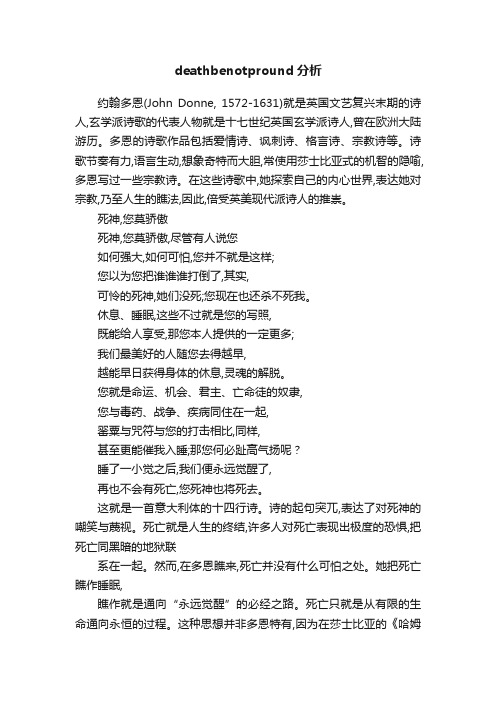
deathbenotpround分析约翰多恩(John Donne, 1572-1631)就是英国文艺复兴末期的诗人,玄学派诗歌的代表人物就是十七世纪英国玄学派诗人,曾在欧洲大陆游历。
多恩的诗歌作品包括爱情诗、讽刺诗、格言诗、宗教诗等。
诗歌节奏有力,语言生动,想象奇特而大胆,常使用莎士比亚式的机智的隐喻,多恩写过一些宗教诗。
在这些诗歌中,她探索自己的内心世界,表达她对宗教,乃至人生的瞧法,因此,倍受英美现代派诗人的推崇。
死神,您莫骄傲死神,您莫骄傲,尽管有人说您如何强大,如何可怕,您并不就是这样;您以为您把谁谁谁打倒了,其实,可怜的死神,她们没死;您现在也还杀不死我。
休息、睡眠,这些不过就是您的写照,既能给人享受,那您本人提供的一定更多;我们最美好的人随您去得越早,越能早日获得身体的休息,灵魂的解脱。
您就是命运、机会、君主、亡命徒的奴隶,您与毒药、战争、疾病同住在一起,罂粟与咒符与您的打击相比,同样,甚至更能催我入睡;那您何必趾高气扬呢?睡了一小觉之后,我们便永远觉醒了,再也不会有死亡,您死神也将死去。
这就是一首意大利体的十四行诗。
诗的起句突兀,表达了对死神的嘲笑与蔑视。
死亡就是人生的终结,许多人对死亡表现出极度的恐惧,把死亡同黑暗的地狱联系在一起。
然而,在多恩瞧来,死亡并没有什么可怕之处。
她把死亡瞧作睡眠,瞧作就是通向“永远觉醒”的必经之路。
死亡只就是从有限的生命通向永恒的过程。
这种思想并非多恩特有,因为在莎士比亚的《哈姆雷特》“生存还就是死亡”这一著名的内心独白中,莎士比亚也曾根据西方人的宗教思想把死亡比作睡眠,但就是,把死神作为无能而又自傲的形象进行如此淋漓尽致的讥讽,恐怕只有出现在多恩的作品中。
这首诗说理多于抒情。
从诗的结构来瞧,第一、二行“死亡,不要骄傲,虽然有人说您/强大而又可怖,而您并不真的这样”,就是论点,而第二行到第八行就是论据,说明死亡没有什么可怕,死亡同睡眠没有多少不同,都可以使人“获得身体的休息,灵魂的解脱”。
对托尼·莫里森小说死亡主题的分析
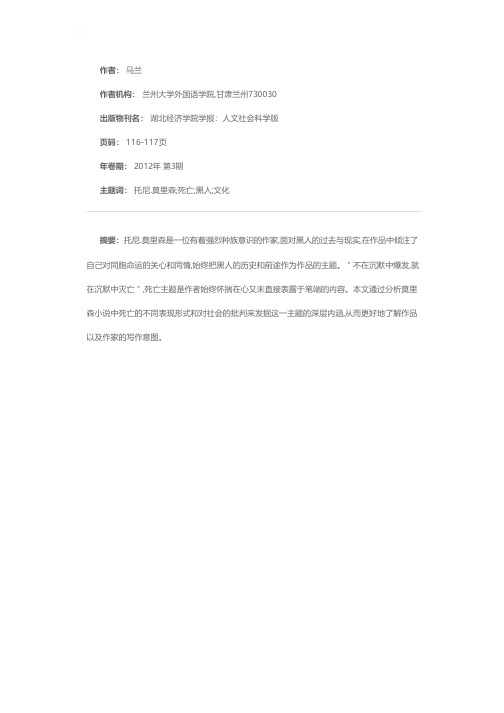
作者: 马兰
作者机构: 兰州大学外国语学院,甘肃兰州730030
出版物刊名: 湖北经济学院学报:人文社会科学版
页码: 116-117页
年卷期: 2012年 第3期
主题词: 托尼.莫里森;死亡;黑人;文化
摘要:托尼.莫里森是一位有着强烈种族意识的作家,面对黑人的过去与现实,在作品中倾注了自己对同胞命运的关心和同情,始终把黑人的历史和前途作为作品的主题。
"不在沉默中爆发,就在沉默中灭亡",死亡主题是作者始终怀揣在心又未直接表露于笔端的内容。
本文通过分析莫里森小说中死亡的不同表现形式和对社会的批判来发掘这一主题的深层内涵,从而更好地了解作品以及作家的写作意图。
认知隐喻学视域下《哈姆雷特》中的“死亡”隐喻分析

认知隐喻学视域下《哈姆雷特》中的“死亡”隐喻分析第一篇范文在认知隐喻学视域下,本文试图对莎士比亚的经典作品《哈姆雷特》中的“死亡”隐喻进行深入分析。
死亡作为人生不可避免的终结,自古以来便成为文学创作中的重要主题。
认知隐喻学认为,人类对抽象概念的理解往往依赖于具体的认知经验,而死亡作为抽象概念,在文学作品中往往通过具体的隐喻手法呈现出来。
《哈姆雷特》作为莎士比亚的代表作之一,死亡这一主题贯穿全文。
本文将从以下几个方面对文中的“死亡”隐喻进行分析:自然死亡、暴力死亡、精神死亡等。
一、自然死亡隐喻在《哈姆雷特》中,自然死亡隐喻主要体现在角色的生命周期上。
例如,哈姆雷特的父亲在剧本开始时便被毒死,母亲的再婚以及弟弟克劳狄斯的篡位,都体现了自然死亡隐喻的存在。
此外,哈姆雷特的朋友霍拉旭也预言了自己将在战争结束后死去,这些角色命运的安排都构成了自然死亡隐喻的体现。
二、暴力死亡隐喻在《哈姆雷特》中,暴力死亡隐喻主要表现在角色间的复仇冲突上。
哈姆雷特为父报仇,克劳狄斯则为保住王位而企图杀害哈姆雷特。
这些冲突中,暴力死亡隐喻无处不在。
例如,在剧本中,剑成了复仇的象征,哈姆雷特与拉奥提斯的剑斗便是暴力死亡隐喻的体现。
三、精神死亡隐喻在《哈姆雷特》中,精神死亡隐喻主要体现在角色心理层面的死亡。
哈姆雷特在剧本中的大部分时间都处于痛苦、矛盾、犹豫的状态,他试图为父报仇,但却陷入了对人生、命运的深度思考。
这种精神层面的死亡,使他陷入了无法自拔的境地。
此外,克劳狄斯在剧本最后因罪恶感而精神崩溃,也体现了精神死亡隐喻的存在。
第二篇范文在探讨《哈姆雷特》中的“死亡”隐喻时,我们可以采用3W1H(What, Why, Who, How)模型和BROKE(Background, Reason, Object, Knowledge, Evaluation)模型来重新审视这一经典主题。
What(什么):首先,我们要明确《哈姆雷特》中的“死亡”隐喻究竟有哪些?它们是如何被运用的?在剧本中,死亡被用作描述生命终结、复仇、精神崩溃等多个层面的隐喻。
乐观还是悲观迪金森的《因为我不能为死亡停留》的语调分析
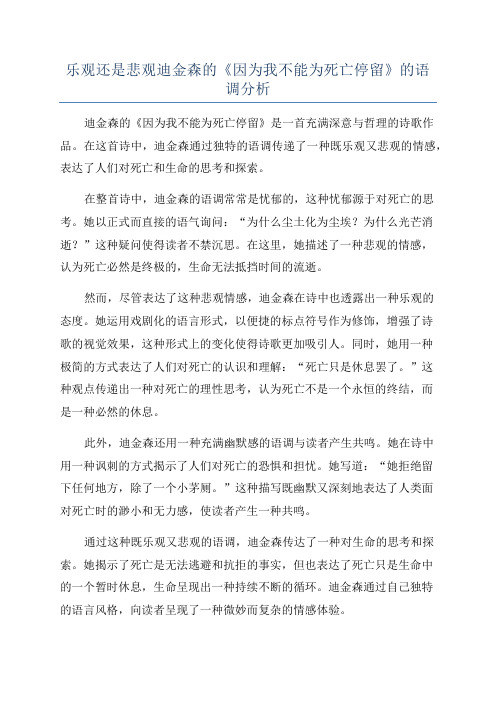
乐观还是悲观迪金森的《因为我不能为死亡停留》的语调分析迪金森的《因为我不能为死亡停留》是一首充满深意与哲理的诗歌作品。
在这首诗中,迪金森通过独特的语调传递了一种既乐观又悲观的情感,表达了人们对死亡和生命的思考和探索。
在整首诗中,迪金森的语调常常是忧郁的,这种忧郁源于对死亡的思考。
她以正式而直接的语气询问:“为什么尘土化为尘埃?为什么光芒消逝?”这种疑问使得读者不禁沉思。
在这里,她描述了一种悲观的情感,认为死亡必然是终极的,生命无法抵挡时间的流逝。
然而,尽管表达了这种悲观情感,迪金森在诗中也透露出一种乐观的态度。
她运用戏剧化的语言形式,以便捷的标点符号作为修饰,增强了诗歌的视觉效果,这种形式上的变化使得诗歌更加吸引人。
同时,她用一种极简的方式表达了人们对死亡的认识和理解:“死亡只是休息罢了。
”这种观点传递出一种对死亡的理性思考,认为死亡不是一个永恒的终结,而是一种必然的休息。
此外,迪金森还用一种充满幽默感的语调与读者产生共鸣。
她在诗中用一种讽刺的方式揭示了人们对死亡的恐惧和担忧。
她写道:“她拒绝留下任何地方,除了一个小茅厕。
”这种描写既幽默又深刻地表达了人类面对死亡时的渺小和无力感,使读者产生一种共鸣。
通过这种既乐观又悲观的语调,迪金森传达了一种对生命的思考和探索。
她揭示了死亡是无法逃避和抗拒的事实,但也表达了死亡只是生命中的一个暂时休息,生命呈现出一种持续不断的循环。
迪金森通过自己独特的语言风格,向读者呈现了一种微妙而复杂的情感体验。
总结起来,迪金森的《因为我不能为死亡停留》既具有悲观的思考,又融入了乐观的态度。
她通过诗中的语调和形式,深入探讨了死亡和生命的话题,使读者感受到这种既乐观又悲观的情感体验。
这首诗不仅带给人们一种思考和启发,同时也展现了迪金森优雅的诗歌才华。
从文学作品翻译中看英汉死亡禁忌语

从文学作品翻译中看英汉死亡禁忌语作者:田佳禾来源:《校园英语·中旬》2017年第05期【摘要】对于死亡的禁忌和避讳是中文与英文共有的语言文化现象,虽然两者有着不少相似的表达法,但在具体的应用上仍有一定的差异。
本文以《哈利波特与死亡圣器》的英文原版和中文译本为例,观察了其中对于死亡的描述方法,总结了英汉中死亡禁忌语的特点,并比较了两者的异同;此外观察了英译汉过程中对于直接与委婉描述的的处理,从而为英汉翻译和跨文化交际提供指导。
【关键词】禁忌语死亡翻译英汉对比一、引言在世界各国的语言中,都存在着大量的“禁忌语”。
所谓禁忌语,是指因社会习惯、宗教习俗或语言联想等原因,在语言使用中避免使用的词语。
对于死亡、疾病、排泄等令人不悦的事情,或是信仰、隐私等容易出现冒犯的话题,人们往往会采用回避、替代、模糊等方式委婉地避开直接、明确的描述。
无论是在英语中还是在汉语中,都通常会避讳直接提及死亡,也有着大量的用于代替“死亡”或是“die”的委婉表达,这一点从文学作品中也能体现出来。
本文将以《哈利波特与死亡圣器》(下文简称《哈7》)的原文和译本做为研究对象,分析其中对于“死亡”的描述和翻译,观察英语和汉语中禁忌语使用的异同,从而为跨文化交际和翻译提供指导。
二、英汉死亡禁忌语的特点人类各种语言的禁忌语具有趋同性。
这里的趋同性是指,对于类似的禁忌物,不同语言中常常会出现相似的委婉表达。
对于英汉两种语言来说也不例外,针对“死亡”的禁忌语和委婉语都有着一定的相似之处。
1.死亡的直接表达。
汉语中对于死亡最为直接的描述就是“死”和“死亡”,对应英语中的“die”、“bedead”和“death”。
直接的描述常常用于第三方叙述死亡事件(例1)。
相较于中文通常使用动词,英文在叙述已经死亡的状态时也常常使用形容词和名词(例2、例3、例4)。
可以看出,中文和英语对于死亡最基础的描述虽在词性选用上有所不同,但总体来说比较一致。
(1)(Surely you have heard) Of how Godelot died in his own cellar after his son,Hereward, took the wand from him?也听说过,戈德洛特在儿子赫瑞沃德拿走魔杖后,死在了自家地窖里吧?(Chapter 21, The Tale of the Three Brothers)(2)Meanwhile, in Gaddley, a Muggle family of five has been found dead in their home.同时,在加德里,有麻瓜一家五口死在家中。
死亡变奏曲
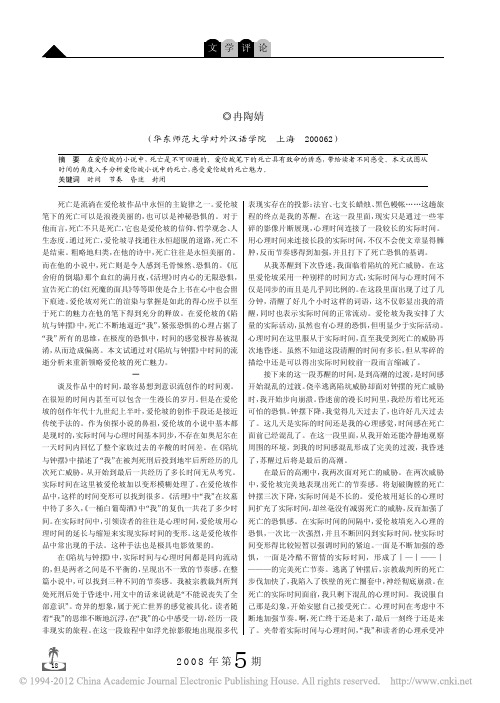
舍府的倒塌》 那个血红的满月夜, 活埋》 《 时内心的无限恐惧, 里爱伦坡采用一种别样的时间方式: 实际时间与心理时间不
18
2008 年第
5期
安徽文学
文 学 评 论
向了顶峰, 将军来了, 一切结束了。 在高潮处爱伦坡停下了这 “那些恶魔是可以随意止住钟摆的” 我成功逃离死亡钟摆时, , 首死亡旋律, 但是在读者心中则依旧回旋着这首死亡旋律的 余音。 实际时间在不断的缩短, 但是心理时间及其节奏却在加快, 直 至最后的高潮。 实际时间的缩短恰恰是通过心理时间来表现 的。 实际时间与心理时间之间形成了完美的二重奏。 不断加 强的心理时间节奏使实际时间的流逝形成一种变形, 流淌并 贯穿在整部作品中的正是这不断改变的心理时间与变形的实 际时间。然而二者之间的不一致并没有造成不和谐感, 反而 二 在这几段里面, 昏迷被反复地提及。在爱伦坡的死亡时 间中昏迷是一个重要的过渡因素。 实际时间与心理时间在昏 迷上得以整合。在每次的昏迷后, 实际时间与心理时间必定 呈现出不同的面貌。每一次的昏迷也不尽相同, 第一次没有 完全丧失意识的昏迷, 第二次坚持了几个小时后的睡去, 第三 次完全不醒人事, 不短的时间还是很长的时间, 我不知道, 我 的时间感已经模糊了。 从每次的昏迷可以看出我时间观念的 改变, 并且与昏迷后的时间感是相吻合的。昏迷使实际时间 与心理时间得到短暂的统一, 同时也能使读者的时间在混乱 的实际时间与心理时间中得到依附。 昏迷的效应不仅如此。 从文章的开头到结束, 我是唯一的存在, 围绕着我的只有实际 时间与心理时间。几乎形成完美的 “密室” 来自外界的干扰 , 很少, 关于这种干扰下文会提及。一开始我以为自己在坟墓 时, 我感受到的是虚空, 黑暗的空间, 不知实际时间的空间。 这种密室使我精神高度集中, 在爱伦坡别的小说中可以看到 这种 “密室” 的效果。 《泄密的心》 中杀手沉浸在自己的思绪 中, 活埋》 《 里我在坟墓中感受到的死亡恐惧, “密室” 实 在 中, 际时间与心理时间往往混淆在一起, 给读者带来强烈的心理 中这种 “密室” 的效果几乎贯穿全文, 但高潮却是一步一步接 近的。在高潮的设置上, 昏迷能够使读者得到喘息。正是不 断地昏迷, 清醒, 节奏不断地改变使密室的时间变化, “密 使 室” 多样化, 最终达到实际时间与心理时间的混合, 高潮来临 了。 但是这种密室并不是完全封闭的。 文中不仅我而且读者 也能清楚地感受到来自外界的目光。 这种外界的目光不是我 的心理时间, 也不是我的实际时间, 是凌驾于我所有时间的存 在。相对于这种外界的目光, 我的实际时间也许用物理自然 时间来表示更为恰当。 这种外界的目光是一种历史的时间。 在最初的昏迷中我意识到的所有片断都是历史时间的象征: 七支蜡烛、 法官、 黑色的幔帐……我侥幸逃离陷坑威胁的时 候, “头顶传来一种声音, 好像有人在急速的开门关门。一丝 微弱的光线划破黑暗, 又迅急消失。 我再次苏醒的时候, 我 ” “ 的身体状况发生了很大的变化” 我面朝上地被捆绑了, 水罐子 也不见了。我再一次苏醒并意识到钟摆没有下降时, 我认为
英汉“死”的认知隐喻对比分析
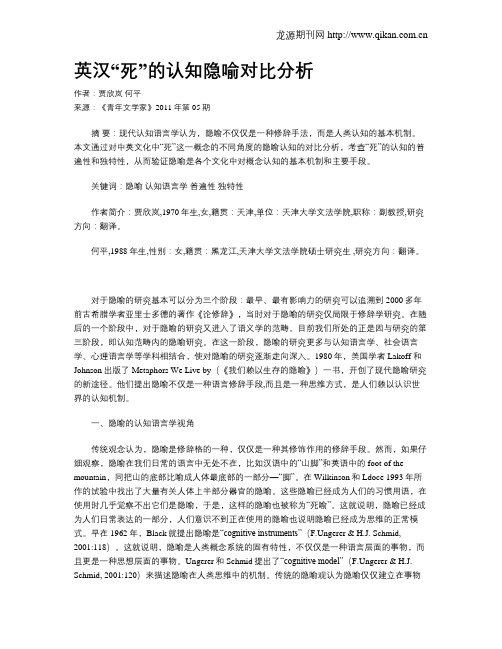
英汉“死”的认知隐喻对比分析作者:贾欣岚何平来源:《青年文学家》2011年第05期摘要:现代认知语言学认为,隐喻不仅仅是一种修辞手法,而是人类认知的基本机制。
本文通过对中英文化中“死”这一概念的不同角度的隐喻认知的对比分析,考查“死”的认知的普遍性和独特性,从而验证隐喻是各个文化中对概念认知的基本机制和主要手段。
关键词:隐喻认知语言学普遍性独特性作者简介:贾欣岚,1970年生,女,籍贯:天津,单位:天津大学文法学院,职称:副教授,研究方向:翻译。
何平,1988年生,性别:女,籍贯:黑龙江,天津大学文法学院硕士研究生 ,研究方向:翻译。
对于隐喻的研究基本可以分为三个阶段:最早、最有影响力的研究可以追溯到2000多年前古希腊学者亚里士多德的著作《论修辞》,当时对于隐喻的研究仅局限于修辞学研究。
在随后的一个阶段中,对于隐喻的研究又进入了语义学的范畴。
目前我们所处的正是因与研究的第三阶段,即认知范畴内的隐喻研究。
在这一阶段,隐喻的研究更多与认知语言学、社会语言学、心理语言学等学科相结合,使对隐喻的研究逐渐走向深入。
1980年,美国学者Lakoff 和Johnson出版了Metaphors We Live by(《我们赖以生存的隐喻》)一书,开创了现代隐喻研究的新途径。
他们提出隐喻不仅是一种语言修辞手段,而且是一种思维方式,是人们赖以认识世界的认知机制。
一、隐喻的认知语言学视角传统观念认为,隐喻是修辞格的一种,仅仅是一种其修饰作用的修辞手段。
然而,如果仔细观察,隐喻在我们日常的语言中无处不在,比如汉语中的“山脚”和英语中的foot of the mountain,同把山的底部比喻成人体最底部的一部分—“脚”。
在Wilkinson和 Ldoce 1993年所作的试验中找出了大量有关人体上半部分器官的隐喻。
这些隐喻已经成为人们的习惯用语,在使用时几乎觉察不出它们是隐喻,于是,这样的隐喻也被称为“死喻”。
这就说明,隐喻已经成为人们日常表达的一部分,人们意识不到正在使用的隐喻也说明隐喻已经成为思维的正常模式。
death be not proud修辞手法

“Death be not proud”这句话使用了修辞手法中的“倒装”。
在英语中,正常的语序应该是“Be not proud, death”,但这里把“not”放在了“be”的前面,形成了倒装。
这种修辞手法可以强调某个词或短语,使句子更加生动有力。
此外,这句话还使用了抽象化的修辞手法,将死亡拟人化,赋予它以骄傲的情绪。
这种修辞手法可以增强句子的表现力,使读者更加深刻地感受到死亡的威力和不可战胜性。
总之,“Death be not proud”这句话使用了倒装和拟人化的修辞手法,强调了死亡的威力和不可战胜性,表达了作者对死亡的深刻思考和感悟。
death be not proud赏析
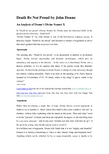
Death Be Not Proud by John DonneAn Analysis of Donne's Divine Sonnet XIn "Death be not proud" (Divine Sonnet X), Donne turns his rhetorical skills on his greatest poetic adversary - death itself.“Divine Sonnet X” by John Donne is one of his best-known religious poems. It famously begins “Death be not proud” and advances a stream of arguments to prove that man’s greatest fear has no power over him.ApostropheThe opening line, “Death be not proud”, is an apostrophe or address to an abstract figure. Donne favours apostrophes and dramatic monologues, which give an immediacy and urgency to his rhetoric –in his career as a churchman, Donne was a famous preacher, so it’s no surprise that many of his poems sound like dramatic speeches. In rhetorically picking on death, Donne is taking on a big adversary, though not entirely without precedent. There is an echo in the opening of St. Paul’s famous demand in 1Corinthians 15:55, “O death, where is thy sting? O grave, where is thy victory?”Ads by GoogleLearn Italian in Italy Join one of our small group road trips around God Can Give Y ou New Life Learn From This True Life Story How God Can Change Y our Life ArgumentsRather than developing a single line of logic, Donne throws several arguments at Death to try to humble it. “those whom thou think’st thou dost ovethrow/ Die not”he declares, without fully explaining what he means at this point. “Rest and sleep” seem to be the “pictures” of death, and these are enjoyable, he argues, so the real thing must be even more pleasant –and in any case “soonest our best men with thee do go”; if the good die young, why should anyone want to avoid it?In a brilliant turn of argument, Donne tells Death that it is not “mighty and dreadful” because it is merely a functionary, a “slave to fate, chance, kings and desperate men”. Anything which can be whistled for by so many despicable causes is hardly to berespected. Its habitat is amongst “poison, war and sickness”, a realm which no-one would want to rule. This is typical Donne: grandiose, verbally aggressive, and picking up any argument, however specious or inconsistent, which can serve to support his cause. He even goes so far as to patronize the Grim Reaper, calling it “poor death” and demanding “why swell’st thou then?”Read This Next∙John Donne Biography∙John Donne's Divine Sonnet VII∙The Canonization - Stanzas 4 & 5ConclusionAs the poem ends he elaborates on his earlier statement that “those whom thou think’st thou dost overthrow/ Die not...nor yet can’st thou kill me”, by pointing out that for Christians, death is merely the beginning of eternal life: “one short sleep past, we live eternally.” He encapsulates this in an even shorter phrase in the last line, mingling the consolation of the Christian faith with a paradox, and triumphing “Death will be more no more, death, thou shalt die.”In Death Be Not Proud, John Gunther explores the process of death: discovery, fighting, living on, and then dying. The process becomes just a little bit easier, as humor, human kindness and courage all are woven in. More than just about dying, this memoir becomes a study of living.Gunther asked himself the larger questions: "Why was Johnny being subjected to this merciless experience?" And, then he says, "suffering is an inevitable part of most lives." He wanted to believe there was some greater purpose, like the works of art that came out of Milton's blindness and Beethoven's deafness. He says, "perhaps the entire harrowing episode would make his brain even finer, subtler, and more sensitive than it was."Of course, Johnny's brain did not become sharper. Even early in the process of fighting the brain tumor, he seems to feel that death is inevitable, as Johnny laments: "I have so much to do! and there's so little time!" In a very literary sense, his statement is foreshadowing his untimely end, but there's also a feeling of eagerness, of an absolute passion for life. He wants to see what he can do, what he can accomplish! He's still so young, and there's a certain amount of impetuous naivety mingled with absolute realism.We know Death will win, but Death need not be proud. Johnny fought a valiant fight; and, along the way, he gained the respect of his family, friends, his doctors, and strangers. His life becomes a sort of experiment. And, in the end, the doctors could do nothing. "All the doctors!--helpless fliesnow, climbing across the granite face of death."Johnny was sometimes able to function at a level that could almost be called "normal," but he was continually faced with the realization that his mind was deteriorating. His memory began to fail him, as more of the healthy tissue was taken over. As Gunther writes, "All that goes into the brain--the goodness, the wit, the sum total of enchantment in a personality, the very will, indeed the ego itself--being killed inexorably, remorselessly, by an evil growth!" And, no matter what new treatments they tried, they couldn't find a cure.A Fight to the DeathThe struggle against death is a fight against the void, against the loss of life--the spark. It is, as Gunther says:"A primitive to-the-death struggle of reason against violence, reason against disruption, reason against brute unthinking force--this was what went on in Johnny's head. What he was fighting against was the ruthless assault of chaos. What he was fighting for, as it were, the life of the human mind."Ultimately, Death came, like a thief in the night. The warmth of his body crept away. "Then little by little the life-color left his face, his lips became blue, and his hands were cold."He was 17 years old. He would have attended Harvard. But, none of that mattered, as everyone who knew him remembered his life. Frances writes of her grief and remembrance: "My grief, I find, is not desolation or rebellion at universal law or deity. I find grief to be much simpler and sadder... All the things he loved tear at my heart because he is no longer here on earth to enjoy them. All the things he loved!"Like John Gunther, Frances asks the big questions: "What does it mean? What can it mean, now?" But, then she draws upon the universality to her discussion of death: "Parents all over the earth who lost sons in the war have felt this kind of question, and sought and answer. To me, it means loving life more, being more aware of life, of one's fellow human beings, of the earth."。
哈姆雷特_生与死_Tobe_or_not_to_be_一解
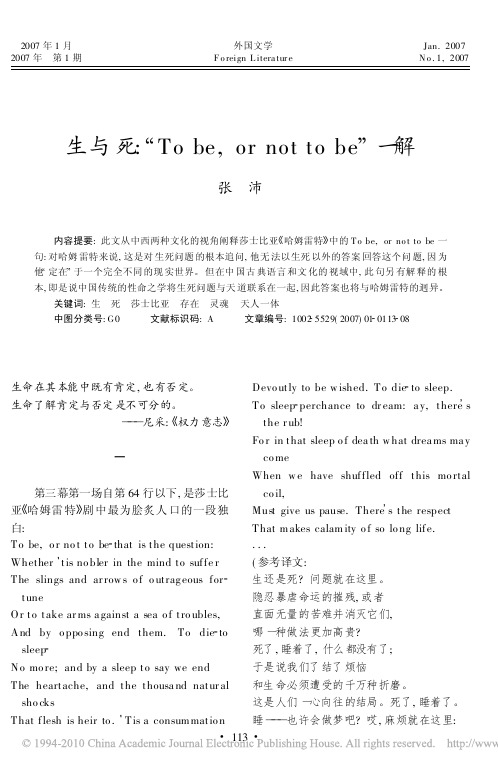
the quest io n, 总领下面长达三十二行的长篇 的动词。
独白, 同时也是全剧的题眼和总纲, 是本剧甚
那么 t o be, o r no t t o be 这句话中的 to
至是所有莎剧中最重要的一句台词。它的中 be 是什么意思呢? 在这句话中, to be 单独
文译文不下十种, 例如朱生豪译为 生存还是 出现, 后面没有跟任何表语或状语, 因此它表
sho cks
这是人们一心向往的结局。死了, 睡着了。
T hat f lesh is heir to . T is a consum mat io n 睡 # # # 也许会做梦吧? 哎, 麻烦就在这里:
∃ 113 ∃
2007 年
外国文学
第1期
当我们摆脱了尘世的烦恼之后,
故我在 ( 或可译 我思即我在 ) , 这句话的拉
还是从古 希腊说 起。根据 柏拉 图的叙 述, 苏格拉底临死前 告诉弟 子: 灵魂 是存在 的, 生命 不会 断灭; 从 生 中 产生 死 , 从 死 中 产 生 生 , 生 # 死 相 互 流 转 不 已。 生 生 死 很好理解, 为什么说 死 生 生 呢? 苏格拉底用归谬法证明了这一点:
如果产生的过程不是从对立的一方到另
一方, 然后再返回来, 兜着圈子转, 而是永远 以一直线向前, 没有返回或转折, 那么, 你明 白, 到了最后一切事物都成了一样的, 都达到 同一状态, 就根本停止产生了。
如果一切有生命的东西都会死, 如果死 者在死后始终处在那种状态中, 岂不是到最 后必然一切 都是死 的, 没有 一个是活 的吗? 因为如果活的不是从死的产生, 而是从别的 产生, 而活的又必要死, 怎能避免到头来一切 事物都要同归于死呢? ( 柏拉图, 2004: 227 #
生死英文谚语
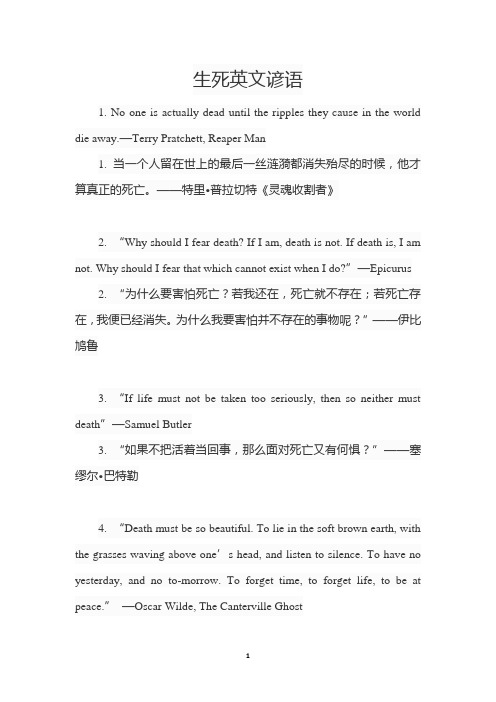
生死英文谚语1. No one is actually dead until the ripples they cause in the world die away.—Terry Pratchett, Reaper Man1. 当一个人留在世上的最后一丝涟漪都消失殆尽的时候,他才算真正的死亡。
——特里•普拉切特《灵魂收割者》2. “Why should I fear death? If I am, death is not. If death is, I am not. Why should I fear that which cannot exist when I do?”—Epicurus2. “为什么要害怕死亡?若我还在,死亡就不存在;若死亡存在,我便已经消失。
为什么我要害怕并不存在的事物呢?”——伊比鸠鲁3. “If life must not be taken too seriously, then so neither must death”—Samuel Butler3. “如果不把活着当回事,那么面对死亡又有何惧?”——塞缪尔•巴特勒4. “Death must be so beautiful. To lie in the soft brown earth, with the grasses waving above one’s head, and listen to silence. To have no yesterday, and no to-morrow. To forget time, to forget life, to be at peace.”—Oscar Wilde, The Canterville Ghost4. “逝去是如此美好。
躺在褐色柔软的泥土里,小草在你头顶上摇曳,聆听着安静的沉默。
没有昨天,也没有明天。
忘记时间,忘记一切,享受着永恒的安宁。
”——奥斯卡•王尔德《古堡守护灵》5. The ones that love us never really leave us.—Sirius Black, Harry Potter and the Prisoner of Azkaban5. 爱我们的人绝不会真正离我们而去。
英美文学选读-作者及年代
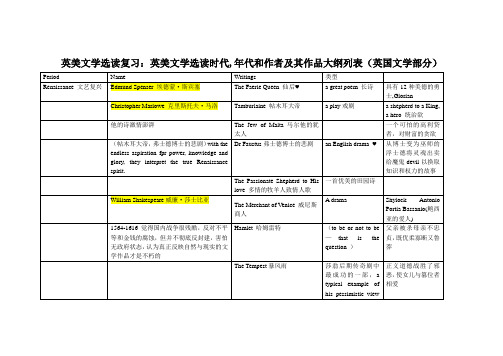
英美文学选读复习:英美文学选读时代,年代和作者及其作品大纲列表(英国文学部分)文学名词:讽喻Allegory 如《仙后》白体诗Blank Verse 人文主义humanism 玄学派Metaphysical如约翰邓恩文艺复兴Renaissance 十四行诗sonnet18英美文学选读:英美文学选读时代,年代和作者及其作品大纲列表(英国文学-新古典主义)文学名词:启蒙运动The Enlightenment 崇尚理性,平等和科学,主张人有能力完善自己,完善社会新古典主义Neoclassicism17世纪末到18世纪中叶主宰了英国文学的一种古典主义倾向哥特式小说Gothic Novel以魔法,神秘,超自然因素为主要特色的一种小说,运用鬼混,怪物以及诸如旧城堡,地牢,墓场等背景造成一种险恶,可怕的氛围。
英雄双韵体诗Heroic couplet英美文学选读:英美文学选读时代,年代和作者及其作品大纲列表(英国文学-浪漫主义)拜伦式英雄Byronic hero 是拜伦塑造的一种典型人物形象,常常出身显贵,傲慢而神秘英美文学选读:英美文学选读时代,年代和作者及其作品大纲列表(英国文学-维多利亚)功利主义Utilitarianism检验伦理观念的方法就是看它是否对社会有用戏剧独白Dramatic monologue决定论Determinism人的行为和事件都是由决定它们的种种因素控制和导致的一种信仰或理论(Eliot的决定论有两个原因:内因和外因)自然主义Naturalism流行于19世纪晚期,在宇宙中人是被他所生存的环境和遗传因素控制的一种生物英美文学选读复习:英美文学选读时代,年代和作者及其作品大纲列表(现代部分)英美文学选读复习:英美文学选读时代,年代和作者及其作品大纲列表(美国部分)浪漫主义时期:加尔文主义Calvinism 通过上帝的特殊恩典的输入而获得有限的赎罪美国清教主义American Puritanism 那些由于各种原因来到新大陆并在美国定居下来的清教徒们的信仰和习俗超验主义transcendentalism 相信人能够通过直觉认识真理,或者超越感官获得知识自由诗体Free verse 有节奏的诗行长短不一,不符合任何固定的一样个牧师或传统的押韵体系。
Explication on Death, Be Not Proud(John Donne的Death, Be Not Proud英文诗歌鉴赏)
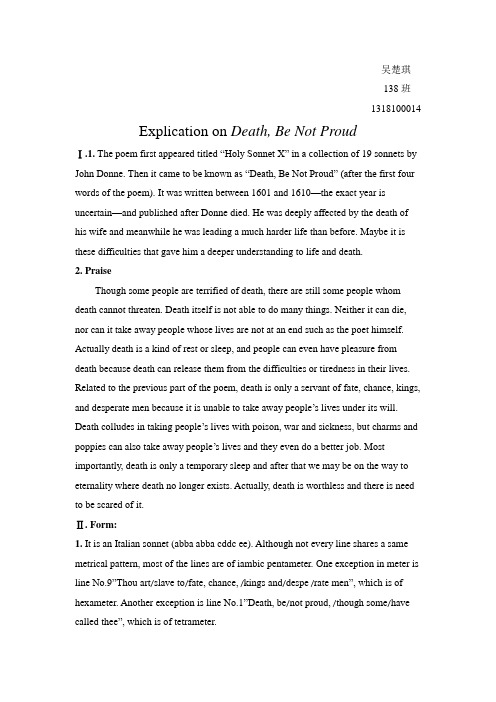
吴楚琪138班1318100014 Explication on Death, Be Not ProudⅠ.1. The poem first appeared titled “Holy Sonnet X” in a collection of 19 sonnets by John Donne. Then it came to be known as “Death, Be Not Proud” (after the first four words of the poem). It was written between 1601 and 1610—the exact year is uncertain—and published after Donne died. He was deeply affected by the death of his wife and meanwhile he was leading a much harder life than before. Maybe it is these difficulties that gave him a deeper understanding to life and death.2. PraiseThough some people are terrified of death, there are still some people whom death cannot threaten. Death itself is not able to do many things. Neither it can die, nor can it take away people whose lives are not at an end such as the poet himself. Actually death is a kind of rest or sleep, and people can even have pleasure from death because death can release them from the difficulties or tiredness in their lives. Related to the previous part of the poem, death is only a servant of fate, chance, kings, and desperate men because it is unable to take away people’s lives under its will. Death colludes in taking people’s lives with poison, war and sickness, but charms and poppies can also take away people’s lives and they even do a better job. Most importantly, death is only a temporary sleep and after that we may be on the way to eternality where death no longer exists. Actually, death is worthless and there is need to be scared of it.Ⅱ. Form:1. It is an Italian sonnet (abba abba cddc ee). Although not every line shares a same metrical pattern, most of the lines are of iambic pentameter. One exception in meter is line No.9”Thou art/slave to/fate, chance, /kings and/despe /rate men”, which is of hexameter. Another exception is line No.1”Death, be/not proud, /though some/have called thee”, which is of tetrameter.2. ⑴Alliteration: almost the whole is written in alliteration and the following aresome examples:For th ose whom th ou th ink'st th ou dost over th rowD ie not, poor D eath, nor yet c anst thou k ill meM uch pleasure; th en f rom th ee m uch m ore m ust f low⑵Personification: the poet personifies the Death as a person, and the personification shows in adjectives like “proud” which shows the emotion or feeling of the Death, and the poet called the Death “thee (you)” and “salve to fate...”. Moreover, the poet also personifies the fate, sickness, poison and so on.⑶Metaphor: As the founder of metaphysical school, the poet uses conceit in the poem. He compares death to sleep, which is a rarely used metaphor. The metaphor shows the poet’s fearlessness and calmness to death.⑷Paradox: The last line “Death, thou shalt die” uses paradox because it’s wired to ask death itself to die. This shows the poet’s contempt for death.Ⅲ. Content1. Theme: The theme is “human’s contempt for death”. The poem tells the reader that death has no right to be proud, since human beings do not die but live eternally after “one short sleep.” The poet lifts the dreadful and mighty mask of death by explaining the fact death cannot control our lives and what really dominate are fate, opportunity and so on. Most importantly, people’s lives can be eternal.2. Evaluation: As one of the most popular English poem in the history, Death, Be Not Proud represents a detached and shows contempt and calmness for death, and points out death cannot decide people’s lives and lives could never end. The poem reflects the poet’s detached and bold attitude towards death as well as his religious belief. It’s a very special opinion about death at that time and I think it also helps diversifyh umans’ views to death and encourage people lessen the fear to death. Similarly, the poet mentions some people died and they free themselves from all the misery in their lives. John Donne offers us a different angle of viewing death.。
death be not proud; john donne
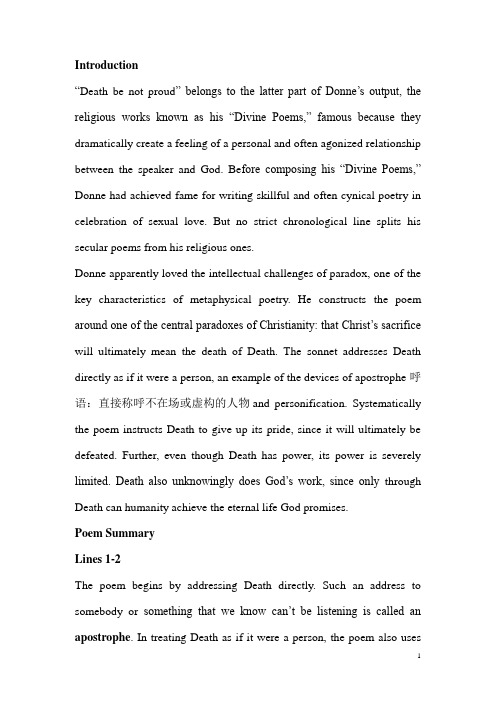
Introduction“Death be not proud”belongs to the latter part of Donne’s output, the religious works known as his “Divine Poems,” famous because they dramatically create a feeling of a personal and often agonized relationship between the speaker and God. Be fore composing his “Divine Poems,” Donne had achieved fame for writing skillful and often cynical poetry in celebration of sexual love. But no strict chronological line splits his secular poems from his religious ones.Donne apparently loved the intellectual challenges of paradox, one of the key characteristics of metaphysical poetry. He constructs the poem around one of the central paradoxes of Christianity: that Christ’s sacrifice will ultimately mean the death of Death. The sonnet addresses Death directly as if it were a person, an example of the devices of apostrophe呼语:直接称呼不在场或虚构的人物and personification. Systematically the poem instructs Death to give up its pride, since it will ultimately be defeated. Further, even though Death has power, its power is severely limited. Death also unknowingly does God’s work, since only through Death can humanity achieve the eternal life God promises.Poem SummaryLines 1-2The poem begins by addressing Death directly. Such an address to somebody or something that we know can’t be listening is called an apostrophe. In treating Death as if it were a person, the poem also usesthe device of personification. The first two lines show one characteristic of Donne’s Poetry: they often take the form of an argument.The first two lines of the sonnet attacks Death for its pride. Unlike other people, the speaker does not think that death is “mighty and dreadful.”Then he gives the reasons in the rest of the poem.Lines 3-4The two lines introduce a paradox, stating that the people Death “overthrows” do not really die, and that Death is not even str ong enough to kill the speaker. In declaring Death’s powerlessness, the speaker even goes so far as to express his pity for death, calling it “poor Death.” But “poor” also suggests a note of contempt for Death’s impotence, its poverty of resources.Lines 5-6The second quatrain develops the idea that Death is not to be feared. Instead, the speaker maintains that death is a source of pleasure. The speaker draws the conventional analogy between Death and “rest and sleep,” which are Death’s “pictures.”Since we find rest and sleep pleasurable, we should find that Death can provide us much more pleasure. Then in the next two lines, the speaker gives us another example to prove his idea.Lines 7-8Here the speaker gives evidence of Death’s pleasantness by saying that “our best men” die early. Here, however, the poem argues in anunconventional way, saying it is no tragedy that the best men die young. Rather, they die willingly, eager to let their bodies rest in the grave so that their souls are liberated and go to heaven as soon as possible. Through the use of this piece of evidence, the poem argues that Death is not powerful, that the terror we traditionally associate with death is groundless, and that Death provides the pious Christian a genuine and pleasurable reward. Lines 9-10The ninth line of an Italian sonnet, the form whose rhyme scheme this poem follows, usually marks a turn: a shift in the tone between the eight-line octave and the six-line sestet. However, this poem behaves structurally more like a Shakespearean sonnet. Instead of a strong change in tone or argument, line 9 continues developing the speaker’s attack on Death. Death is not man’s master; in fact, it is a slave of those who bring death to others, including the forces of fate and chance, here personified, and the real persons of kings. Death also is a slave to “desperate men,” that is, people in despair who commit suicide.Lines 11-12In the two lines, the speaker continues developing the idea that death should not be proud. Death’s fellows or family are not noble companions, but something horrible and disgusting: poison, war, and sickness, all personified.Death’s ability to make us sleep can be equaled or surpassed by drugs such as opium or by magic spells. The speaker then ends with a rhetoricalquestion asking death why it should be so proud.Lines 13-14The sonnet’s last 2 lines ends the poem by offering the ultimate evidence of Death’s powerlessness. In lines 5-6 and 11, the speaker has introduced the conventional analogy of sleep to death. At the end of the poem, however, the speaker argues that they are the same. Death is a short sleep, from which we will wake up and enter eternal life.This statement explains all the paradoxes in the poem: Death is not an ending but a beginning. Further, Death provides the means for its own defeat, since by dying we will overcome Death, and Death will die. ThemesDeathThe most prominent theme of the poem is that one should not fear death. Death is warned directly to “be not proud.” It is belittled violently as a slave whose job — providing rest and sleep for the soul is better done by drugs or simple magic charms. However, the very forcefulness with which the speaker berates death indicates some doubt on the poet’s pa rt. If death were truly defeated, the speaker would not have to rail so loudly against it. The poem implies an unspoken fear that death can still be powerful —only good and faithful Christians will enjoy eternal life, while everyone else will spend eternity suffering the pains of hell. Appearances and RealityAnother major theme is that death seems mighty, but in reality, it is not.Though the stillness death brings seems to be permanent, the poet asserts, we will awake from it on Judgment Day. Though death seems proud and overpowering, it in fact is always accompanied by poison, war, and sickness. Though it appears dreadful, death is but a slave to “fate, chance, kings,” and even lowly “desperate men.” Despite its apparent ability to strike humans down, the poet claims that humble drugs or magic spells can do death’s work much better. Above all, death’s permanence is an illusion. According to the poet’s Christian faith, death will come to an end at the final judgment day, when the world will end and all people who ever lived will come back to life. On this day, God will bring good people to heaven and send evil people to hell, where they will live for eternity. StyleIn its form, the poem is an Italian sonnet, written, like most sonnets, in iambic pentameter. The Italian sonnet’s thematic o rganization usually has two parts: an eight-line octave and a six-line sestet. The thematic organization of “Holy Sonnet 10,” however, more closely resembles the structure of a Shakespearean sonnet (also called an English sonnet) since there is not a strong change in tone or argument. The octave follows the conventional Petrarchan rhyme scheme of abbaabba, while the sestet rhymes cddcee, one of several conventional patterns.。
爱伦·坡小说的死亡主题解读

爱伦·坡小说的死亡主题解读一.死亡的奇异之美坡十分注重美学效果,他强调作品对读者所能唤起的心情和发生的效果。
他以为,“那种最剧烈最高尚同时又最纯真的快乐存在于对美的凝神观照之中,美是灵魂的激动,或许说是灵魂愉悦的升华。
”[1]坡经过制造惧怕奥秘的气氛,怪诞新奇的情节来烘托死亡的奇异之美,让人的内心震撼,灵魂得以升华。
坡在小说的故事气氛方面承袭了传统哥特小说的梦境气氛,又大肆渲染暴力与惧怕,突出了封锁压制的共同效果。
故事大都发作在鬼魅的中央——幽闭的城堡、古宅、卧室、书房、地窖、藏尸所。
这些场景都有共同的特点,它们整天不见阳光、黑暗压制,给人以一种朦胧而惧怕骇人的气氛。
而作者也经过各种惧怕的词汇,如坟墓、阴霾、病态等,来渲染死亡的气息。
《厄舍府的倒塌》是最能表现这种惧怕气氛的短篇小说。
故事自始至终都弥漫着令人毛骨悚然的气氛。
坡的小说惧怕不只体如今缜密的气氛营建上,还体如今精巧的故事情节布置上。
坡经过大胆奇异的想象设计了光怪新奇的故事情节,使惧怕的局面一步步延伸,让全文到达高潮。
《厄舍府的倒塌》中玛德琳死尸复生一段是这篇小说最为惧怕新奇的情节。
坡首先为死尸复生作了一系列铺垫,如叙事者总是尽力压制自己的惧怕心思,觉得玛德琳并没有真正死去,在那个灾难性的夜晚,他有一种难以忍受、十分剧烈的惧怕感。
于是,为了减轻这样的惧怕他末尾阅读《疯狂的特里斯特》,而故事中那啪啪啦啦的破门声、毒蛇临死前的惨叫声与理想中玛德琳棺材的劈开声、囚牢铰链的摩擦声和地下室的挣扎声交相辉映,使小说的惧怕抵达了高潮。
当披着血袍、“体无完肤”、“骨瘦如柴”的玛德琳站在门口,“摇摇晃晃……重重地摔倒在哥哥身上……他被拽到地上,成了具尸体,一个惧怕的牺牲品”,[2]小说到此惧怕的力气全部迸发了出来,随着古邸的轰然倒塌,读者的心灵也遭到了无比的震撼。
这篇小说每一个情节都旨在营建一个惧怕的效果,让读者真正体会到了“心灵的惧怕”,感遭到了惧怕的魔力,奥秘而梦境,充溢了奇异的美,震撼人的心灵。
death be not proud韵律

题目:《“逝去不要骄傲”韵律分析》目录:一、引言二、《逝去不要骄傲》的作者及背景三、《逝去不要骄傲》的韵律分析1. 押韵2. 格律3. 节奏4. 语调四、《逝去不要骄傲》的意境五、《逝去不要骄傲》与原著主题的关联六、结论引言《逝去不要骄傲》这首诗作出自英国文学家约翰·邓恩(John Donne),以其独特的韵律和对逝去的思考而著称。
本文将通过对这首诗的韵律分析,探讨其韵律之美,以及诗人对逝去的深刻思考。
《逝去不要骄傲》的作者及背景约翰·邓恩(1572年-1631年),英国文学的巨匠之一,英国文学史上享有崇高地位。
他是文艺复兴时期最伟大的爱情诗人之一,其作品以真情实感、奇想幻想著称。
邓恩的诗集中,《逝去不要骄傲》被认为是他最著名的作品之一。
《逝去不要骄傲》的韵律分析1. 押韵《逝去不要骄傲》这首诗采用了十四行诗的形式,每四行为一个边四年的押韵格式,符合英国文学中的押韵规则。
这种押韵形式给人一种平和、稳定的感觉,与诗中对逝去的冷静思考相呼应。
2. 格律《逝去不要骄傲》采用了十四行诗的格式,每行十个音节,符合英国文学中的十四行诗(也称为彼特拉克或莎士比亚十四行诗)的传统格律。
这种格式既能保持诗歌的韵律美感,又能使诗人表达清晰。
诗人精心编排每一个音节,给人以深刻的思考。
3. 节奏《逝去不要骄傲》的节奏悠扬,每个音节都呈现出一种节奏感,使全诗具有一种柔美的韵律。
通过这种节奏,诗人使诗歌更加生动,给人以深刻的印象。
4. 语调《逝去不要骄傲》的语调既庄严又平实,既有对逝去的深刻思考,又有对生活的热爱。
这种语调给人以一种宁静、恬淡的感觉,使人更加沉浸在诗歌的意境之中。
《逝去不要骄傲》的意境《逝去不要骄傲》这首诗通过对逝去的深刻思考,表现出诗人对生命的热爱和珍惜。
诗中对逝去的描述,既有对逝去的无奈,又有对生命的珍惜。
这种意境给人以深刻的思考,在面对逝去时,我们应该珍惜生命,努力奋斗。
《逝去不要骄傲》与原著主题的关联《逝去不要骄傲》的主题是对逝去的思考和对生命的珍惜。
Mortality is Mortal
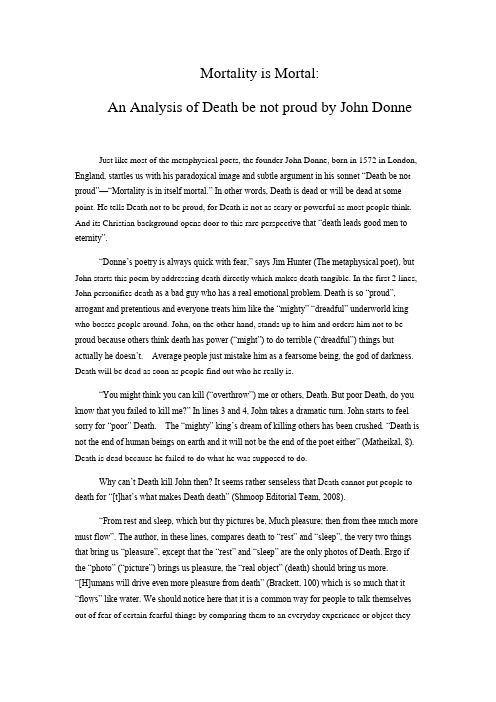
Mortality is Mortal:An Analysis of Death be not proud by John DonneJust like most of the metaphysical poets, the founder John Donne, born in 1572 in London, England, startles us with his paradoxical image and subtle argument in his sonnet “Death be no t proud”—“Mortality is in itself mortal.” In other words, Death is dead or will be dead at some point. He tells Death not to be proud, for Death is not as scary or powerful as most people think. And its Christian background opens door to this rare perspect ive that “death leads good men to eternity”.“Donne’s poetry is always quick with fear,” says Jim Hunter (The metaphysical poet), but John starts this poem by addressing death directly which makes death tangible. In the first 2 lines, John personifies deat h as a bad guy who has a real emotional problem. Death is so “proud”, arrogant and pretentious and everyone treats him like the “mighty” “dreadful” underworld king who bosses people around. John, on the other hand, stands up to him and orders him not to be proud because others think death has power (“might”) to do terrible (“dreadful”) things but actually he doesn’t. Average people just mistake him as a fearsome being, the god of darkness. Death will be dead as soon as people find out who he really is.“You might think you can kill (“overthrow”) me or others, Death. But poor Death, do you know that you failed to kill me?” In lines 3 and 4, John takes a dramatic turn. John starts to feel sorry for “poor” Death. The “mighty” king’s dream of killing others has been crushed. “Death is not the end of human beings on earth and it will not be the end of the poet either” (Matheikal, 8). Death is dead because he failed to do what he was supposed to do.Why can’t Death kill John then? It seems rather senseless that D eath cannot put people to death for “[t]hat’s what makes Death death” (Shmoop Editorial Team, 2008).“From rest and sleep, which but thy pictures be, Much pleasure; then from thee much more must flow”. The author, in these lines, compares death to “rest” and “sleep”, the very two things that bring us “pleasure”, except that the “rest” and “sleep” are the only photos of Death. Ergo if the “photo” (“picture”) brings us pleasure, the “real object” (death) should bring us more. “[H]umans will drive even more pleasure from death” (Brackett, 100) which is so much that it “flows” like water. We should notice here that it is a common way for people to talk themselves out of fear of certain fearful things by comparing them to an everyday experience or object theyenjoy. Death is only a strong version of sleep or rest that we experience every day. Mortality is mortal when it pleases instead of scares us.Surely, “our best men”, the bravest, will go with “death” one day. But it doesn't mean he has killed us. That self-a ssured god of death just leads us to a place where we can “rest our bones”. And he might not notice that our souls are delivered. It is only our bodies he took but our souls give birth to new lives. Most people believe that “[t]he speaker almost certainly refers to people like soldiers and martyrs, who sacrifice themselves for the greater good” (Shmoop Editorial Team, 2008). But in my opinion, this has something to do with John’s wife. It is said that “[h]is wife aged thirty-three died in 1617, shortly afte r giving birth to their twelfth child, a stillborn.”(The Academy of American poets). This period of time coincides with the time when the poem is first published. There is a great chance that “our best men” refers to his dead wife whose life is continued b y their kids. “[A]nd, the sonnet probably reflects the theme of hope he attempted to pass to the grieved” (Brackett, 100). His wife, just like others’, is willing to die in order to bring new life and hope to the world. Death is dead and defeated by the reproduction of human beings.In lines 9 to 10, John shifts to be aggressive towards death. Death is not as remarkable as he thought. He is nothing but a “slave” to “fate, chance, kings, and desperate men,” so death himself is not free. He is manipulated by “fate” who tells people when they will die, by “chance” who tells people what might happen to them, by “kings” who change people’s (criminals’) fate, sending them to die and by “desperate men” who commit suicide simply because there’s no reason to live. He only cooperates (“dwells”) with “poison, war and sickness” to kill innocent people in painful ways. But “sadly”, mortality is mortal without his “masters and gangsters”.Why do we need death to put us to sleep when we have “poppy or charms”? From line 11 and 12, we can tell that John looks down on Death for Death is no better than others who can do us the favor when we have trouble sleeping. The rhetorical question, “why swell’st thou then”, brings out the theme that “Death be not proud”. Why would Deat h be proud when he is not irreplaceable?“One short sleep past, we wake eternally, and death shall be no more; Death, thou shalt die”Finally, we got our answer. John comes back to the idea of death is only a short sleep. In a Christian way of thinking, d eath is only a sleep for a certain period of time. When the “Judgment Day” comes, the “dead good people”, who were actually asleep, will be awake. Jesus will lead them to Heaven where they will enjoy eternity. “Death is not a conqueror. It is merely an instrument which liberates man from his mortal body and elevates him into the world of eternity where death has no power” (Matheikal, 8). At that point, there will not be death any more. Mortality comes to an end and it is mortal in a Christian way.It is typical that metaphysical poets end their poems with contradiction. In this poetry, John challenges the general fear of death, by arguing that there is no reason to be afraid. Just as Matheikal said, “Death is self-destructive. When it kills, it is dying itself; it is transporting man's life to where that life will be beyond the faintest influence of death” (8). Mortality is mortal, and then eternity shall come.Works citedBrackett, V (2008), The Facts On File Companion to British Poetry, 17th and 18th Centuries, New York: Facts On File, Inc.Matheikal, T (2001), English Poetry: From John Donne to Ted Hughes, New Delhi: Atlantic, Ltd.Shmoop Editorial Team. (November 11, 2008).Death, be not proud (Holy Sonnet 10).Retrieved December 19, 2012, from/death-be-not-proud-holy-sonnet-10/The Academy of American Poets (2012). , John Donne. Retrieved December 19, 2012, from /poet.php/prmPID/243。
乐观还是悲观:迪金森的《因为我不能为死亡停留》的语调分析
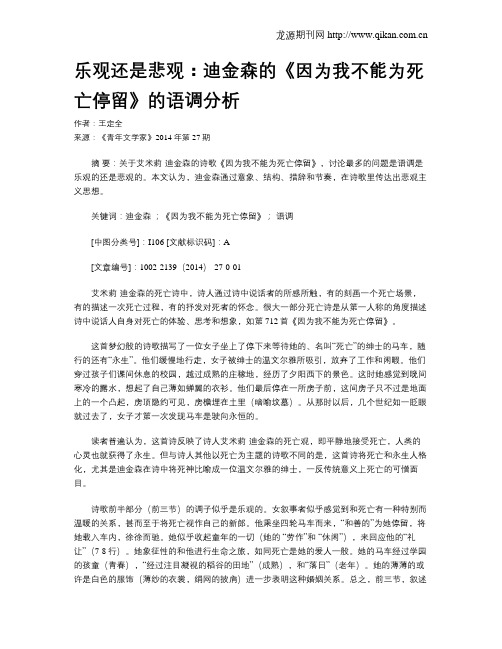
乐观还是悲观:迪金森的《因为我不能为死亡停留》的语调分析作者:王定全来源:《青年文学家》2014年第27期摘要:关于艾米莉·迪金森的诗歌《因为我不能为死亡停留》,讨论最多的问题是语调是乐观的还是悲观的。
本文认为,迪金森通过意象、结构、措辞和节奏,在诗歌里传达出悲观主义思想。
关键词:迪金森;《因为我不能为死亡停留》;语调[中图分类号]:I106 [文献标识码]:A[文章编号]:1002-2139(2014)-27-0-01艾米莉·迪金森的死亡诗中,诗人通过诗中说话者的所感所触,有的刻画一个死亡场景,有的描述一次死亡过程,有的抒发对死者的怀念。
很大一部分死亡诗是从第一人称的角度描述诗中说话人自身对死亡的体验、思考和想象,如第712首《因为我不能为死亡停留》。
这首梦幻般的诗歌描写了一位女子坐上了停下来等待她的、名叫“死亡”的绅士的马车,随行的还有“永生”。
他们缓慢地行走,女子被绅士的温文尔雅所吸引,放弃了工作和闲暇。
他们穿过孩子们课间休息的校园,越过成熟的庄稼地,经历了夕阳西下的景色。
这时她感觉到晚间寒冷的露水,想起了自己薄如蝉翼的衣衫。
他们最后停在一所房子前,这间房子只不过是地面上的一个凸起,房顶隐约可见,房檐埋在土里(暗喻坟墓)。
从那时以后,几个世纪如一眨眼就过去了,女子才第一次发现马车是驶向永恒的。
读者普遍认为,这首诗反映了诗人艾米莉·迪金森的死亡观,即平静地接受死亡,人类的心灵也就获得了永生。
但与诗人其他以死亡为主题的诗歌不同的是,这首诗将死亡和永生人格化,尤其是迪金森在诗中将死神比喻成一位温文尔雅的绅士,一反传统意义上死亡的可憎面目。
诗歌前半部分(前三节)的调子似乎是乐观的。
女叙事者似乎感觉到和死亡有一种特别而温暖的关系,甚而至于将死亡视作自己的新郎。
他乘坐四轮马车而来,“和善的”为她停留,将她载入车内,徐徐而驰。
她似乎收起童年的一切(她的“劳作”和“休闲”),来回应他的“礼让”(7-8行)。
Because I Could Not Stop For Death赏析(3页)
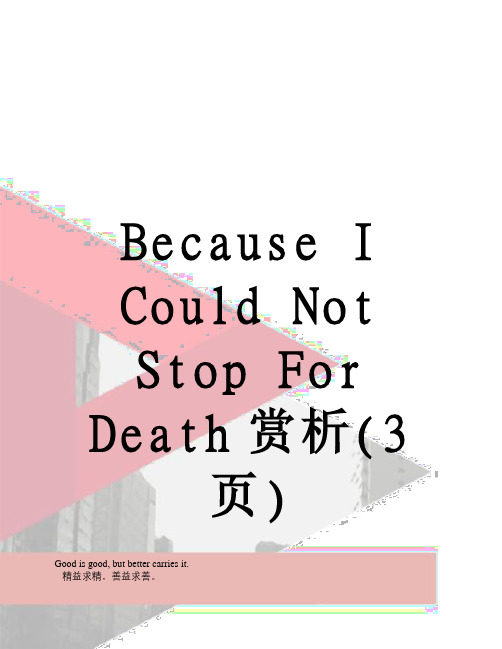
Because ICould NotStop For Death赏析(3页)Good is good, but better carries it.精益求精,善益求善。
Because I Could Not StopFor Death赏析In this poem, Dickinson describes dying and immortality in the dominant metaphor of a carriage on a journey.In Stanza 1, Death, accompanied by Immortality, stops to pick up the speaker in a carriage. In stanzas 2-4, they journey, leaving earthly life behind them (labor, leisure, children, grain, setting sun). In stanza 5, they pause before the grave (swelling of the ground), and stanza 6 depicts the speaker centuries later, speaking from eternity.This one--- Because I Could Not Stop for Death, which brims over with religious theme is just a perfect evidence. As Dickinson’s poems usually had no titles, and the first sentence of a poem is taken as its title.The poem begins with a leisurely image. At first, the protagonist feels totally at ease and the usually frightening death is described as if a familiar friend, gentle and polite. Continuingly, the poem is developed upon a basic metaphor that life is a journey. It was truly rather old a comparison, but Dickinson enriched it with her creativity and imagination School,where Children strove --childhood; Fields of Gazing Grain--maturity; and Setting Sun--old age. Then “the Dews drew quivering and chill-” makes the protagonist feel terribly cold, which may mean that they are getting nearer and nearer to the tomb. But at last, his companions,Immortality and Death, finally desert him and leave him alone to go toward Eternity.So it seems that though death cheats him and at the same time deserts him, the experience of death itself is not painful. Emily Dickinson’s poems just explain thiskind of essence of life, which then lead you to a world of imagination and thinking.。
- 1、下载文档前请自行甄别文档内容的完整性,平台不提供额外的编辑、内容补充、找答案等附加服务。
- 2、"仅部分预览"的文档,不可在线预览部分如存在完整性等问题,可反馈申请退款(可完整预览的文档不适用该条件!)。
- 3、如文档侵犯您的权益,请联系客服反馈,我们会尽快为您处理(人工客服工作时间:9:00-18:30)。
约翰多恩(John Donne, 1572-1631)是英国文艺复兴末期的诗人,玄学派诗歌的代表人物是十七世纪英国玄学派诗人,曾在欧洲大陆游历。
多恩的诗歌作品包括爱情诗、讽刺诗、格言诗、宗教诗等。
诗歌节奏有力,语言生动,想象奇特而大胆,常使用莎士比亚式的机智的隐喻,多恩写过一些宗教诗。
在这些诗歌中,他探索自己的内心世界,表达他对宗教,乃至人生的看法,因此,倍受英美现代派诗人的推崇。
死神,你莫骄傲
死神,你莫骄傲,尽管有人说你
如何强大,如何可怕,你并不是这样;
你以为你把谁谁谁打倒了,其实,
可怜的死神,他们没死;你现在也还杀不死我。
休息、睡眠,这些不过是你的写照,
既能给人享受,那你本人提供的一定更多;
我们最美好的人随你去得越早,
越能早日获得身体的休息,灵魂的解脱。
你是命运、机会、君主、亡命徒的奴隶,
你和毒药、战争、疾病同住在一起,
罂粟和咒符和你的打击相比,同样,
甚至更能催我入睡;那你何必趾高气扬呢?
睡了一小觉之后,我们便永远觉醒了,
再也不会有死亡,你死神也将死去。
这是一首意大利体的十四行诗。
诗的起句突兀,表达了对死神的嘲笑和蔑视。
死亡是人生的终结,许多人对死亡表现出极度的恐惧,把死亡同黑暗的地狱联系在一起。
然而,在多恩看来,死亡并没有什么可怕之处。
他把死亡看作睡眠,看作是通向“永远觉醒”的必经之路。
死亡只是从有限的生命通向永恒的过程。
这种思想并非多恩特有,因为在莎士比亚的《哈姆雷特》“生存还是死亡”这一著名的内心独白中,莎士比亚也曾根据西方人的宗教思想把死亡比作睡眠,但是,把死神作为无能而又自傲的形象进行如此淋漓尽致的讥讽,恐怕只有出现在多恩的作品中。
这首诗说理多于抒情。
从诗的结构来看,第一、二行“死亡,不要骄傲,虽然有人说你/强大而又可怖,而你并不真的这样”,是论点,而第二行到第八行是论据,说明死亡没有什么可怕,死亡同睡眠没有多少不同,都可以使人“获得身体的休息,灵魂的解脱”。
第九、十行指出死神的无能,而第十一、二行说明死神并没有什么独特之处,没有什么可资骄傲的理由。
这四行进一步提供论据,来支持诗人的论点。
第十三、四行则是结论。
虽然这首诗有很强的论说性,但表达了诗人对死神的蔑视和无畏之情。
情与理的结合使诗本身具有有说服力,而比喻的运用使这篇说理的诗生动。
整个诗作铿锵有力,富于阳刚之气。
And dost with poison, war, and sickness dwell, And poppy, or charms can make us sleep as well,
这两句描绘了死亡的罪恶肮脏,也进一步表现诗人对死亡的蔑视。
而最后一行作为强有力的结尾,甚至提出“死神将死”的观点,可说是对世俗见解的大胆挑战,彻底削弱了死亡的力量。
说真的感觉还是不像Lake Poets的诗作那样舒服,不
仅因为多处为古英语的关系,还因为诗中缺少画面的营造,尽管不乏新奇大胆的想象,却未免显得美感不足。
该诗以语意的逐层递进为特点,由三组四行诗和一个偶句组成。
第一组四行诗以拟人的手法呼吁死神不要骄傲,(“Death, be not proud”)起句突兀,表达了对死神的嘲笑和蔑视,然后立刻指出死神不应骄傲的第一条理由:For those, whom thou think’st thou dost overthrow, Die not, poor Death, nor yet canst thou kill me.”
第二组四行诗指出死神无需骄傲的另一条理由:死亡不过是更安逸的休息、更甜美的睡眠,“Much pleasure, then from thee much more must f low,”人们都会争着希望得到身体的休息,灵魂的解脱,“Rest of their r bones, and soul’s delivery.”
第三组四行诗嘲笑死神奴隶般的从属地位:“Thou’rt slave to Fate, chance, kings, and desperate men, And dost with poison, war, and sickness dwell,”并以罂粟和咒符来衬托死神的无能为力:“And poppy or charms can make us sleep as well, And better than thy stroke”既然这样,你何必趾高气扬呢?“why swell’st thou then?”这三组四行诗以不同的理由对死神威胁的解构确实已非同一般。
然而,接下来的偶句并不放过对死神的最后一击:睡一小觉之后,我们便永远觉醒了,再也不会有死亡,不可一世的死神将走向自身的死亡,“And Death shall be no more; Death, thou shalt die.”诗歌的说理递进模式在此戛然而止,生与死原有意义上的关系彻底逆转:死亡是瞬间的,将很快不复存在,而死后的欢乐则是永恒的,人对于死亡的畏惧变成了死亡自身的恐惧,死亡对于人来说不过是通往幸福永生的大门。
这种强烈的戏剧化效果和反讽意味的获得最终是通过悖论语言实现的。
